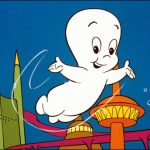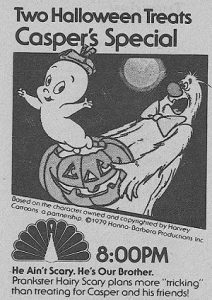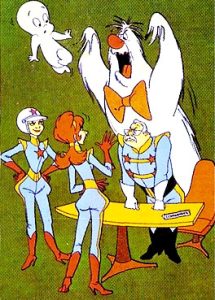



For Hanna-Barbera, 1979 was a time of some offbeat “mash-ups.” Like Fred and Barney Meet the Shmoo, which debuted that same year (and was discussed recently here), Casper and the Angels combined so much in one show and added a dash of a familiar, friendly ghost.
 Although he was the lead, Casper (voiced by Julie McWhirter) materialized as a sidekick/guardian angel character to two female space police officers, Mini (Laurel Page) and Maxi (Diana McCannon), in a futuristic/Jetsons-ish science fiction setting, where they patrol in flying, motorcycle-like vehicles.
Although he was the lead, Casper (voiced by Julie McWhirter) materialized as a sidekick/guardian angel character to two female space police officers, Mini (Laurel Page) and Maxi (Diana McCannon), in a futuristic/Jetsons-ish science fiction setting, where they patrol in flying, motorcycle-like vehicles.
Casper also plays straight man to the comic relief, a scruffy-looking ghost named Hairy Scary (John Stephenson doing an Ed Wynn-inspired voice), who has a red, bulbous nose and sports an oversized bow tie.
Together, they embark on different adventures, from investigating something crooked at a space circus to finding themselves stranded when they take a new spaceship for a spin. Also on the show were Nerdly (Hal Smith) and Fungo (Paul Winchell), two male space police officers who constantly gave Mini and Maxi a hard time.
Casper and the Angels drew its influence from and combined concepts of shows and movies that were popular at the time – a little Charlie’s Angels, a little Laverne and Shirley, and a dose of Star Wars.
“The reality was–and is–that television, in particular, tends to embrace imitation,” said Greg Ehrbar, author of Hanna-Barbera: The Recorded History and host of The Funtastic World of Hanna and Barbera podcast. “Hanna-Barbera’s industry contemporaries did precisely the same thing elsewhere on the network schedules. Charlie’s Angels on ABC became Flying High on NBC and The American Girls on CBS, and that’s one of countless examples.”

Casper and the Angels was a time capsule of when Saturday morning television changed. In their book, Saturday Morning Fever: Growing Up with Cartoon Culture, authors Timothy and Kevin Burke write, “The Seventies were the template for Saturday morning, but by the end of the decade, the formula was in danger of failing, both because of the repeated challenges of critics and because of internal pressures.”
 It was forty-five years ago this fall that Hanna-Barbera started producing Casper shows. In addition to Casper and the Angels, the friendly ghost starred in two prime-time specials produced by the Hanna-Barbera Studios, Casper’s Halloween Special and Casper’s First Christmas (1979).
It was forty-five years ago this fall that Hanna-Barbera started producing Casper shows. In addition to Casper and the Angels, the friendly ghost starred in two prime-time specials produced by the Hanna-Barbera Studios, Casper’s Halloween Special and Casper’s First Christmas (1979).
Of course, Casper had been around for decades before this, first appearing in Famous Studios’ 1945 short subject, The Friendly Ghost. He would go on to appear in over fifty theatrical shorts.
In his book Of Mice and Magic: A History of American Animated Cartoons, Leonard Maltin noted, “Casper, like a growing number of Famous cartoons, was aimed strictly at children – which limited its appeal in theaters but made it doubly marketable in other ways. Later, the Casper cartoons scored an even bigger hit on TV, to such a degree, that a new series of shorts was commissioned in the 1960s.”
Casper’s cartoons would be part of the TV shows Matty’s Funday Funnies (1959) and The New Casper Cartoon Show (1963).
 The shorts usually focused on Casper wanting to do more than scare people but inadvertently doing exactly that until he befriended someone who would accept him.
The shorts usually focused on Casper wanting to do more than scare people but inadvertently doing exactly that until he befriended someone who would accept him.
However, with Casper and the Angels, this plot paradigm changed. Here, Casper would embark on different adventures with the Angels.
Each episode would begin with quick strains of Casper’s theme song at the beginning and end of the opening credits, during which the instrumental theme would show scenes of the sci-fi escapades that were about to come. It was all a different setting from what audiences were used to from the friendly ghost.
“There were real-life reasons such convoluted concepts came to be,” explained Greg Ehrbar, “According to several people who were at the studio back then, it was due to the nature of television since the beginning and the nature of executive decision-making.
 “Joe Barbera pitched three different series concepts, two based on current TV hits, Charlie’s Angels and CHiPs, and another starring Casper. Rather than choosing one, they chose a mix of all three. What the Hanna-Barbera studio had to its advantage was talented people who managed to somehow make it as entertaining as possible, even as the network, sponsors, and pressure groups had their say. Casper and the Angels was certainly not the only unusual series made during this frantic, bizarre, competitive era, but its head-scratching premise is well remembered.”
“Joe Barbera pitched three different series concepts, two based on current TV hits, Charlie’s Angels and CHiPs, and another starring Casper. Rather than choosing one, they chose a mix of all three. What the Hanna-Barbera studio had to its advantage was talented people who managed to somehow make it as entertaining as possible, even as the network, sponsors, and pressure groups had their say. Casper and the Angels was certainly not the only unusual series made during this frantic, bizarre, competitive era, but its head-scratching premise is well remembered.”
Casper and the Angels features work by many tremendous animation-industry talents, including Robert Alvarez, Ed Barge, Gabor Csupo, Hugh Fraser, Robert Gentle, and Phyllis Craig.
Debuting on September 22, 1979, the series would last only half a season until December 15, 1979. Casper would return in other animated series, and most notably on the big screen, in 1995’s live-action/animated feature.
There’s a good chance that Casper will magically reappear again someday, adding to his animated history, which includes a stint with Hanna-Barbera that reflects so much that was popular in 1979.